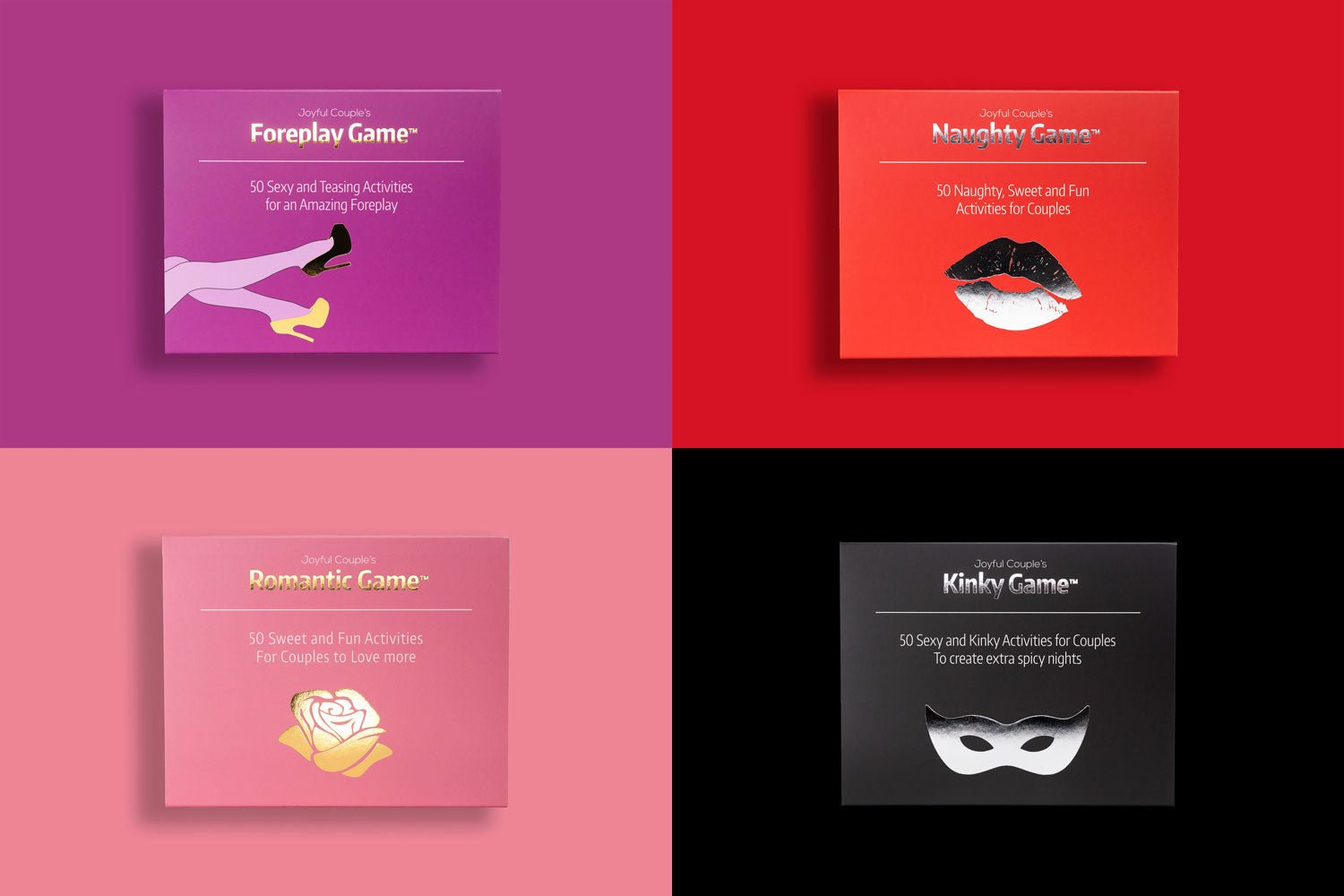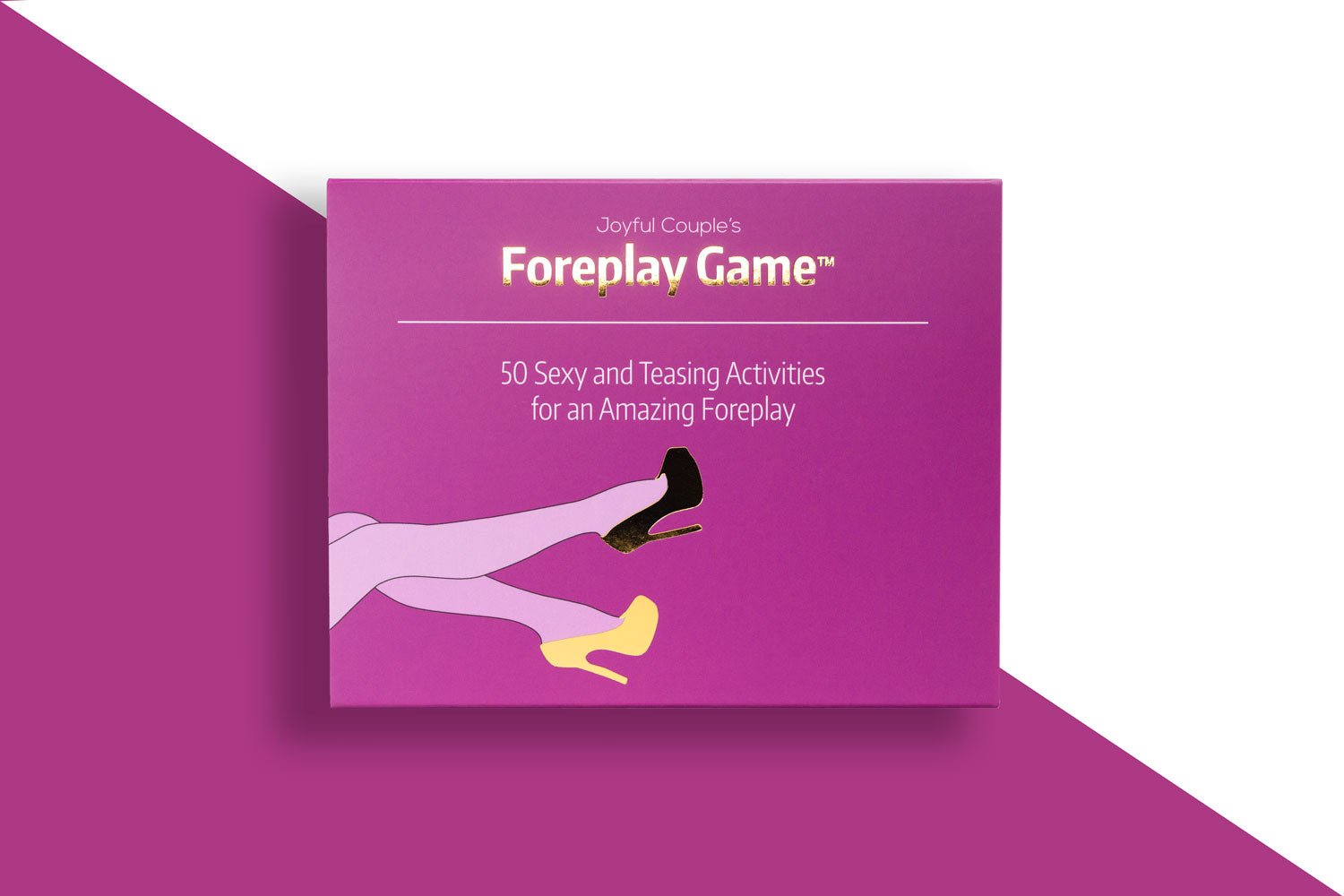Let’s be honest: edging is that delicious moment when you're right on the brink—your body begging for release, your mind locked in the buildup—and then... you pull back. Not yet. Not just yet. That pause? That tease? That’s where the magic starts.
Edging is the art of almost finishing but not quite. It’s about riding that wave and pulling back just before the peak. For some, it’s a solo skill. For others, it’s a couple’s adventure into control, teasing, and trust. Either way, it’s way more than just “lasting longer.” It’s about heightened pleasure, stronger connection, and some seriously steamy build-up.
Whether you’re curious, already playing with edging, or wondering if this might spice up your bedroom routine, this guide breaks it all down—from what edging means, to the tools, games, and kinky twists like gooning and denial that can take things to the next level.
And if you're a couple looking to play, trust us—Joyful Couple has a few very fun ways to get things started.

What Is Edging?
Let’s start with the basics: what is edging, really? Simply put, edging is the practice of getting very close to orgasm, then stopping right before it happens. You let your body build up all that pleasure… and then you back off. Then you do it again. And maybe again. Until finally—when you decide you’re ready—you let go.
So if you’re wondering about the official edging meaning, here it is: edging is all about delaying orgasm to increase arousal, heighten sensitivity, and make the final climax even stronger.
How Edging Works: Body + Brain
When you’re heading toward orgasm, your body floods with feel-good chemicals like dopamine and oxytocin. Muscles tense, your breath quickens, and your brain narrows in on one thing: release.
Edging interrupts that pattern. You pull back just before the peak—letting the pressure cool slightly—then build it back up again. Physically, this keeps arousal high. Mentally, it can feel like riding waves instead of going straight for the finish line.
“Edging helps increase sexual awareness and control, which can improve both solo and partnered experiences,” says Dr. Ian Kerner, sex therapist and author of She Comes First. “It allows people to stretch out pleasure and tune into their body in a new way.” [1]
Plus, it’s one of the easiest ways to break out of autopilot and turn up the connection in the moment.
Why People Try Edging
So, why edge at all? Because the payoff is pretty amazing—and it’s not just about lasting longer.
- Stronger orgasms. The buildup often leads to a more intense, full-body climax.
- More time together. It turns a quick session into something slow, teasing, and exploratory.
- Intimacy boost. Edging with a partner takes communication, trust, and a bit of playful power play.
- Better control. Great for people who finish quickly or want to stay in the moment longer.
- It’s fun. That "so close but not yet" feeling? It’s addictive in the best way.
Foreplay Game - Gateway to Edging
Playing the Foreplay Game is a fantastic way of stepping into the world of edging - this game is meant for teasing and building the tension between you! Play it to get into the flow!
Why People Love It (Even If They Don’t Talk About It)
Edging isn’t just a trick to last longer. It’s a full-on pleasure amplifier—and once people try it, they often keep coming back to it (quietly, of course).
“Edging allows couples to prolong the sexual experience, extend arousal, and create more satisfying intimacy,” according to MasterClass, which explains that people use it to “prolong sexual pleasure” and counteract quick finishes, especially in partnered settings.[2]
Here’s why people are so into it:
- The buildup feels incredible. Holding back means more sensation, more teasing, and a more intense release when you finally let go.
- It keeps you in the moment. You’re focused, engaged, and totally tuned in to what your body (or your partner’s) is feeling.
- It works for all genders. Anyone with a body can benefit from edging—whether solo or together.
- It adds spice to your connection. Especially with edging in a relationship, the shared control, teasing, and slow play can take your intimacy to a deeper, more playful place.

Edging and Denial: What’s the Difference?
Edging and denial often get lumped together, but they’re not quite the same thing. Think of them as close cousins—both about control and anticipation, but with different end goals.
Edging means getting close to orgasm and then backing off, sometimes multiple times, before eventually finishing. Denial, on the other hand, means building up the arousal… and then not finishing at all. Not for a while, at least. The release is intentionally withheld, sometimes for hours, sometimes for days.
“Denial adds a psychological layer to edging,” says sex therapist Dr. Laurie Mintz, author of Becoming Cliterate. “The brain becomes hyper-focused on pleasure, which can actually intensify desire and make intimacy more emotionally charged.”[3]
This combo—edging and denial—can be especially exciting for couples exploring power dynamics or playful control. It’s often used in edging games, where one partner gets to decide when the other can or can’t finish. That kind of teasing can build serious tension (in the best way) and lead to explosive chemistry.
Who enjoys this? Honestly, anyone curious about control, anticipation, and deeper intimacy. It’s not just a kink thing—it’s a connection thing.
And if you want to try it but aren’t sure how to start, Joyful Couple’s relationship games are an easy, non-intimidating way to explore this dynamic. With playful prompts and spicy dares, games like Naughty Game or Kinky Game let you experiment with edging and denial at your own pace.
Gooning: The Deeper (And Kinkier) Side of Edging
If edging is about control, gooning is about surrender. It’s what happens when you edge for so long that your brain slips into a kind of pleasure trance. You’re totally zoned out, completely focused on sensation, and maybe even drooling a little. (No judgment—this is a safe space.)
So, what is gooning? It’s an intense, often immersive form of edging, usually done solo, where you ride wave after wave of arousal without releasing. Over time, you can reach a blissed-out, almost meditative state that some describe as “mindless pleasure.”
How It Relates to Edging
Gooning starts with edging—but it goes deeper. The longer you hold off, the more your mind lets go of distractions, expectations, and even time. You’re not just controlling pleasure anymore—you’re lost in it.
For some, this becomes a form of self-exploration. For others, especially in partner play, it can add a kinky edge to edging and denial dynamics. One partner controls the experience, while the other slips into full surrender mode.
Safe Play, Limits, and Trust
Gooning might sound wild (because it kind of is), but like any intense experience, it works best with clear boundaries. Whether solo or with a partner, it's important to:
- Stay hydrated and grounded
- Use safe words and check-ins
- Take breaks to avoid overstimulation or discomfort (too much of a good thing becomes bad).

Edging Tools and Toys to Try
Ready to take edging from “just an idea” to “wow, that was hot”? There are tons of simple, effective edging tools that can help you stay in control, increase anticipation, and build up to a seriously intense release.
Whether you’re flying solo or getting playful with a partner, here’s a quick rundown of the tools people swear by:
Physical Tools That Crank Up the Tease
- Vibrators with adjustable settings are great for slow build-ups. Start soft, ramp it up, then ease off when you’re getting close.
- Cock rings help maintain arousal without tipping you over the edge.
- Feathers or soft floggers are perfect for sensory play and teasing touch.
- Sensual pleasure ties or cuffs add a layer of power exchange—who’s in control of the edge now?
“Sex toys make sex better… Once you know what brings you to orgasm and have sex toys on the table, it makes bringing a partner into the mix a bit easier,” Gigi Engle told The Pandemic Will Change How We Think Of Sex Toys Forever [4]
App-Controlled Toys (for the Long-Distance Tease)
For couples playing apart, app-controlled toys are the ultimate remote-control edging tools. One person controls the stimulation while the other has to follow the lead. Great for teasing. Dangerous (in a good way) if you're competitive.
Mental Tools: It’s All in the Mind
Not every edging tool buzzes or straps on. Some of the best ones happen upstairs:
- Teasing texts during the day that build anticipation hours before anything starts
- Using timers to create countdowns (“You’ve got 60 seconds—then hands off”)
- Roleplay and dominance games where one partner controls when (or if) the other gets to finish.
And of course, if you’re looking for an easy, low-pressure way to try these ideas as a couple, Joyful Couple’s Kinky Challenges are filled with edging-friendly prompts. It has slow-burn dares, countdowns, and power-play cards built right in.
Edging in a Relationship: How to Do It Right (and What to Avoid)
Edging can be fun, intimate, and seriously hot—but when you're doing it with a partner, it also requires a little extra care. Like anything new in the bedroom, success comes down to communication, trust, and knowing what feels good for both of you.
Start With Consent and Curiosity
If you’ve never talked about edging in your relationship before, don’t overthink it. You don’t need a formal pitch—just a curious, honest conversation.
Try: “I read something about edging… it sounds kind of hot. Want to try it sometime?”
No pressure, just an idea. Many couples find that once they understand the benefits—stronger orgasms, more connection, longer play—they’re open to giving it a try.
Common Mistakes to Avoid
Like anything intimate, edging comes with its learning curve. Here are a few things to steer clear of:
- Skipping aftercare. After intense teasing or denial, emotions can run high. Cuddle, talk, or just lay together. Aftercare helps your bodies and minds come back down smoothly.
- No clear plan. Edging doesn’t always go as expected. Talk ahead of time about what feels good, what doesn’t, and what to do if one of you gets overstimulated or needs a break.
- Ignoring emotions. Sometimes edging brings up unexpected feelings—frustration, vulnerability, or even emotional release. That’s normal. Just check in, be kind, and stay open.
- Thinking it’s only about sex. Sure, the physical payoff is amazing—but edging is just as much about trust, timing, and learning each other’s rhythms.
And remember: if it stops being fun, stop. There’s no prize for pushing past your limits.

How to Start If You’re Brand New
New to edging? Don’t worry—it’s not as intimidating as it sounds. You don’t need special gear, a script, or any experience. You just need some curiosity, a little patience, and a willingness to slow things down.
Couple Edging: Slow, Fun, and Playful
When you bring a partner in, the vibe shifts a little. Now it’s about shared control, teasing, and building trust. Start small. Maybe one of you is “in charge” for the night. Maybe there’s a countdown, a Sensual Pleasure Tie, or a time limit involved. Maybe it’s just hands-off teasing and slow build-up without rushing to the main event.
Whatever it looks like, keep it playful, not performative. This isn’t about doing it “right”—it’s about finding what feels exciting for you two.
Learn Your Limits (And Respect Them)
As with anything intimate, your limits (and your partner’s) are part of the fun. Listen to your body. If something feels too intense, stop. If you’re feeling frustrated or overwhelmed, say something. Edging should feel like a challenge—but a fun one, not a stressful one.
You don’t need to finish every session with a perfect orgasm. Some nights it’s about the tease, the touch, the tension. And that’s more than enough.
Conclusion
Edging might sound simple—just stop before you finish, right? But anyone who’s tried it knows that it's about so much more than that. It’s about teasing your mind as much as your body. It’s about learning to communicate, explore control, and build a shared experience that feels electric.
Whether you’re dipping your toes into edging solo or getting playful with your partner, remember: the goal isn’t just to hold off. It’s to explore, connect, and enjoy the build-up in all its tension-filled glory.
And if you're looking for fun ways to bring this kind of playful control into your relationship, check out Joyful Couple's sexy card games like Intimacy Bingo and The Foreplay Game. They’re the perfect way to play without pressure—and maybe even make edging a regular part of your date nights.
FAQ Section:
1. What does edging mean during sex?
Edging means getting very close to orgasm, then backing off before finishing. This stop-and-go technique helps build tension, heighten sensitivity, and often leads to a much more powerful climax.
2. Is edging good for couples?
Absolutely. Edging in a relationship can improve communication, build trust, and create deeper intimacy. It encourages partners to slow down, tease, and explore each other's desires in a more intentional way.
3. What are some good edging tools to try?
Popular edging tools include adjustable vibrators, cock rings, feathers, soft restraints, and even app-controlled toys for long-distance play. Joyful Couple’s Foreplay Game and Kinky Challenges also include playful dares that support teasing and control-based dynamics.
4. How do I start edging with my partner?
Start with a casual, open conversation. Say something like, “I read about edging and it sounds kind of exciting—want to try it sometime?” Then go slow. Try teasing, timed play, or games that encourage control and anticipation.
5. What’s the difference between edging and denial?
Edging involves stopping stimulation just before climax, then starting again—often leading to orgasm eventually. Denial, however, means delaying orgasm for an extended period (sometimes hours or days) on purpose. Both can be used in playful or kinky ways, depending on your dynamic.
Citations:
- How to Try Edging, the Sex Technique That Takes Teasing to a Whole New Level https://www.self.com/story/what-is-edging-sex
- Guide to Edging: How to Edge Solo or With a Partner https://www.masterclass.com/articles/edging-guide
- https://www.drlauriemintz.com/
- https://www.missgigiengle.com/blog/sex-toy-sales-pandemic








